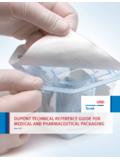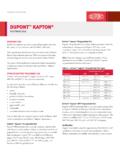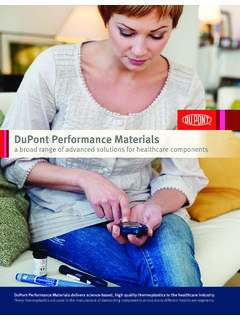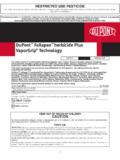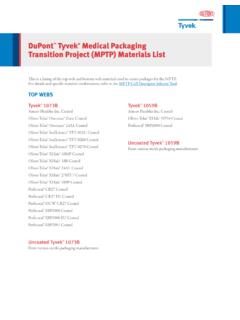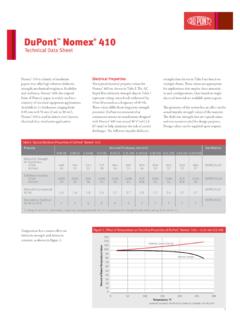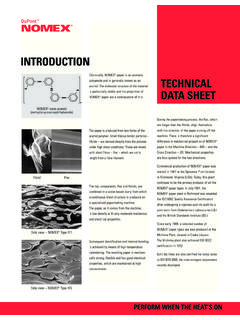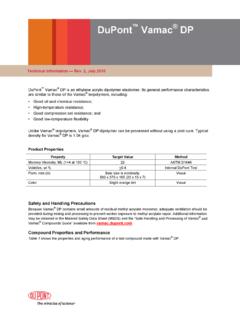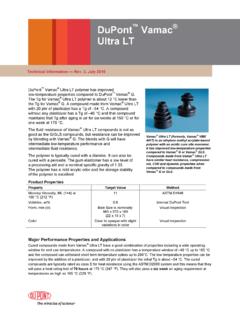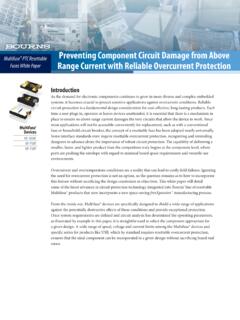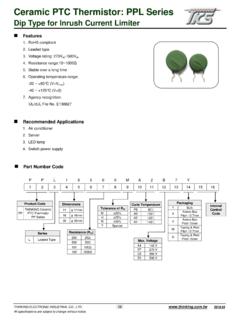Transcription of 7292 PTC CARBON RESISTOR - DuPont
1 DuPont 7292. PTC CARBON RESISTOR . Technical Data Sheet Product Description Ink residence time on screen CARBON -based PTC RESISTOR paste DuPont 7292 > 1 hr can be used in self-regulating heating circuits Screen Types that operate at <80 C. The Positive Temperature Polyester, stainless steel Coefficient (PTC) of the cured film can be used to design circuits which heat up quickly to an equilibrium temperature and then stabilize at that Termination temperature without external controls. DuPont PE825, DuPont PE826, DuPont 5025 or DuPont 5064H polymer thick film silver inks Product Benefits Typical Cure Conditions Self-thermostating temperature control Box oven: 130 C for 10-20 minutes Power reduction at operating temperature Reel-to-reel: 140 C/2min Fast warm-up to operating temperature Thermal stability at 90 C for 24hrs Typical Circuit Line Thickness Printed with 280.
2 Power on/off cycling stability - with rapid mesh Stainless Steel Screen plateau 6-9 microns Adhesive compatibility wide range/choice available Clean-up Solvent Ethylene glycol diacetate Self-Regulating Features For heating/de-misting applications, the required heater resistance is designed around the Table 1. approximate ~15K / paste by placing varying Cured Properties geometry resistors in series or parallel. Depending on the power applied and the ambient temperature when the circuit is powered up, it will Test Properties rapidly heat and self-regulate at the designed Sheet Resistivity K /sq operating temperature.
3 At this point, a considerable increase in resistance will have occurred and a lower power consumption will R Magnification Factor (25-85 C) 8 10x result. Adhesion/Tape Pull No Material (3M Scotch Tape #600) Transfer Processing Substrates This table shows anticipated typical physical properties for DuPont 125 m print treated and heat stabilized 7292 based on specific controlled experiments in our labs and are not polyester intended to represent the product specifications, details of which are available upon request. Screen Printing Equipment Semi-automatic or manual 1.
4 Design Notes Table 2. While the chemical make-up of the DuPont Physical Properties composition 7292 is patented by DuPont , it is advisable to check that specific designs and applications do not infringe on any other patents. Test Properties Heater circuits typically consist of DuPont 7292. CARBON composition overprinted on a silver Viscosity ( ) 15 70. termination having inter-digitized tracks. The [Brookfield RVT UC&SP, 10 RPM, 25oC]. overprinted CARBON composition forms a wide Thinner DuPont 8270. geometry RESISTOR and the distance along the width (between the inter-digitized tracks) is This table shows anticipated typical physical properties for DuPont generally used to target the final heater circuit 7292 based on specific controlled experiments in our labs and are not resistance value.
5 The gap (or spacing) between intended to represent the product specifications, details of which are the silver tracks, determines the power density available upon request. and consequently the heating characteristics of the circuit. Compatibility of Adhesives If an adhesive is used directly over the PTC composition, it Applying Power is essential that the compatibility of the adhesive is When the heater circuit is powered, it will rapidly tested to ensure that the performance of the heater is heat and self- regulate/equilibrate at a not compromised by any adhesive interactions.
6 Adhesive designated temperature. This equilibrium incompatibility may result in erratic /excessive resistance temperature is influenced primarily by a very shifts and/or significant changes in PTC characteristics. large increase in circuit resistance, see Figure 1. See Figure 3, for more details. This is non-linear and generally referred to as Resistance Magnification (or PTC effect). In Printing addition, the equilibrium temperature can be The composition should be thoroughly mixed before use. altered by the design and more specifically, the This is best achieved by slow, gentle, hand stirring with spacing between the silver tracks.
7 An example is a clean burr-free spatula (flexible plastic or stainless given, where 7 heater temperatures are plotted, steel) for 1-2 minutes. Care must be taken to avoid air en- with each having a termination spacing from trapment. Printing should be performed in a clean and well- through to , see Figure2. ventilated area. Within the first few power cycles, a permanent resistance shift is to be expected and the Note: optimum printing characteristics are generally magnitude will be dependent, primarily on the achieved in the room temperature range of 20 C - 23 C.
8 It maximum operating conditions. This has been is therefore important that the material, in its container, is found to be typically less than 10%. It may also at this temperature prior to commencement of printing. Re- result in a slight reduction in PTC performance fer to - Processing Conditions . consequently, it may be necessary to accommodate this shift within the initial design. Drying Allow prints to level at room temperature, then dry in a well Better temperature stability can be expected from -ventilated oven or conveyor dryer. Refer DuPont 7292, see figure 4.
9 Improved stability can to - Processing Conditions . be seen though to 2000 cycles (Power on/off cycles) when comparing to its predecessor Storage and Shelf Life DuPont 7282. Containers should be stored, tightly sealed, in a clean, sta- ble environment at room temperature (<25 C). Shelf life of Hysteresis effect material in unopened containers is six months from date of After the removal of power from a heater circuit, shipment. Some settling of solids may occur and composi- the polymer PTC composition exhibits a tions should be thoroughly mixed prior to use. hysteresis effect.
10 This is basically a time lag in the circuits' ability to return to its original starting resistance. This does not affect the self- Safety and Handling regulating performance but may result in For Safety and Handling information pertaining to this prod- erroneous resistance measurements. uct, read the Material Safety Data Sheet (MSDS). 2. Figure 1: Figure 2: Resistance Magnification (PTC Effect) vs Temperature Equilibrium Temp vs Ag Termination Spacing Figure 3 Figure 4. Adhesive Compatibility Check Powered (12V) Cycling Equilibrium Tempreature Following Composition Adhesive Type Delta R - Post Power On/Off Cycling 85 C Heat Cycle 90.
